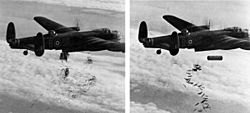Bombing of Duisburg in World War II facts for kids
Quick facts for kids Bombing of Duisburg during World War II |
|||||
|---|---|---|---|---|---|
| Part of Strategic bombing during World War II | |||||
 "Window" (left) and incendiary bombs (right) dropped from an Avro Lancaster plane over Duisburg in 1944 |
|||||
|
|||||
| Belligerents | |||||
| Strength | |||||
| 229 bombing raids | |||||
During World War II, the city of Duisburg in Germany was bombed many times by the Allied forces. The most damaging air raids happened in October 1944, when the city was heavily attacked by the Royal Air Force (RAF).
Duisburg was a very important city for Germany's war efforts. It was a major center for moving goods and had many factories that made chemicals, steel, and iron. Because of this, it was a main target for Allied bombers. Not only were the industrial areas attacked, but also places where people lived. In 1943, the city received daily warnings about incoming bombing raids.
Between 1939 and 1945, the Royal Air Force dropped a total of 30,025 long tons of bombs on Duisburg. This was a huge amount of explosives.
The Battle of the Ruhr
During a period known as the "Battle of the Ruhr" in 1943, a large attack took place. On the night of May 12/13, 577 British bombers attacked Duisburg. They dropped 1,599 tonnes of bombs, which completely destroyed the old part of the city. This attack left 96,000 people without homes.
Operation Hurricane
In October 1944, Duisburg became the main target of a huge operation called Operation Hurricane. This was a joint effort by the RAF Bomber Command and the USAAF Eighth Air Force.
On October 14, 1944, just after sunrise, the RAF Bomber Command sent 1,013 aircraft to bomb Duisburg. RAF fighter planes flew alongside them to protect them. These 957 bombers dropped 3,574 tonnes of powerful explosives and 820 tonnes of incendiary bombs (which cause fires) on the city. Only 14 aircraft were lost during this raid. On the same day, the Eighth Air Force sent 1,251 heavy bombers, with 749 fighter escorts, to bomb targets near Cologne.
Later that same day, during the night of October 14/15, 1,005 RAF bombers returned to Duisburg. They came in two waves, about two hours apart. They dropped another 4,040 tonnes of high explosives and 500 tonnes of incendiary bombs. Only seven aircraft were lost this time. On the same night, another 230 aircraft destroyed the city of Brunswick.
During Operation Hurricane, nearly 9,000 tonnes of bombs fell on Duisburg in less than 24 hours. It is hard to know the exact amount of damage because many records were lost. However, the available documents mention "Very serious property damage" and that "A large number of people [were] buried." Also, at the Thyssen Mines III and IV, 8 days of production were lost due to the damage.
Key Bombing Dates
Here are some of the important bombing raids on Duisburg:
- June 12/13, 1941: The RAF Bomber Command dropped 445 tonnes of bombs.
- April 5/6, 1942: The RAF Bomber Command sent 263 aircraft.
- December 20/21, 1942: The RAF Bomber Command sent 232 aircraft. They reported much damage.
- March 26/27, 1943: A widespread raid by 455 aircraft during the Battle of the Ruhr.
- May 12/13, 1943: The RAF Bomber Command used 577 bombers to destroy the old city with 1,599 tonnes of bombs, making 96,000 people homeless.
- November 23, 1944: Over 140 B-17 planes from the U.S. Eighth Air Force bombed a fuel plant and railway yards in Duisburg.
- October 14/15, 1944: During Operation Hurricane, RAF Bomber Command dropped thousands of tonnes of bombs in two major raids.
- March 5, 1945: The U.S. Ninth Air Force flew missions over the Hamm-Duisburg area.
- April 12, 1945: Fighters from the U.S. Ninth Air Force supported ground troops fighting in the Duisburg and Dortmund areas.
See also

